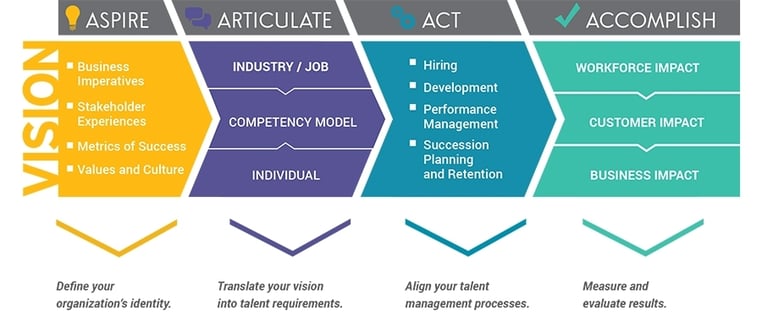Strategic Components of Purpose-Driven Talent Management
HOW DO YOU RESPOND TO A CHALLENGE? Our instincts are usually tactical: Invest in an expensive training program, intensively analyze the production process, revamp the employee hiring and onboarding processes, or explore new technology solutions. While such efforts can yield results, more often than not, they are superficial and short-lived. Why does this happen and how can we do better for our teams?
The 4A Model
Download - The 4A Model: A Roadmap to Purpose-Driven Talent Management
Most business problems have a factor in common; namely, a gap or misalignment in what we call the 4As of talent management. We base our work – and credit our customers’ success – on our 4A Talent Management Model, in which the four components of purpose-driven talent management are tightly linked and aligned with a business and its culture. When even one component is missing or misaligned, the chain is broken, and the business is compromised. We call this “wobble.”
Breaking the Cycle: Talent Management Strategies
A commitment to long-term goals, and active leadership participation.
How many times in your career have you lived through an endless cycle of "fixes” to the same problem? Because most companies don’t take the time or employ the discipline to take a holistic, talent-based view of their business, they succumb to mediocrity and spend years addressing the same problems – over and over.
THE 4A TALENT MANAGEMENT MODEL applies to any company – big or small, new or mature – and requires no special technology or complex managerial process to put it to work. However, it’s not a miracle cure that puts things right overnight. Implementing the model takes executive buy-in, participation, and leadership. It also requires a critical analysis of the business, its culture, and its mission; focus on the intended experiences for customers, employees, and other business stakeholders; and long-term commitment.
 Unsplash+ In collaboration with Getty Images
Unsplash+ In collaboration with Getty Images
But the payoff is big. Our customers who commit to the model have a clear path to growth, achieve financial success, and earn the loyalty of their customers and employees alike.
Clear Vision Drives Business Success & Loyalty
Based on years of work with company founders and senior leaders, we have recognized a strong relationship between the clarity of a company’s vision and business results, such as profitability, customer satisfaction, employee turnover, and share value. Conversely, we have also seen what happens when a company’s vision becomes muddled or diluted – for instance, through rapid growth and the diminishment of direct influence from a company’s founders in running day-to-day operations. Declines in product quality, service, employee productivity, and customer satisfaction levels were common, as well as softening revenues.
Too often, executives assume that hanging a framed mission statement on the walls of each office is synonymous with establishing and reinforcing a corporate vision. Your company’s vision should influence every aspect of business – from the materials you purchase to pricing, from marketing to employee guidelines. Companies that take this work seriously and dedicate the resources required are those that lead their markets and earn valuable customer loyalty.
Are you ready to better understand candidate behavior, characteristics, and traits and reduce your time to hire? With our customizable predictive skills testing and hiring assessments, now you can.
Read our Blog: Employee Engagement Roots and Fruits
Featured image photo Unsplash+ In collaboration with Getty Images




